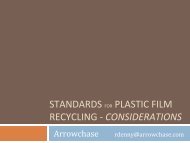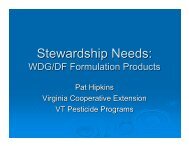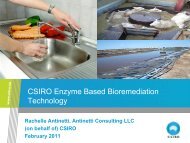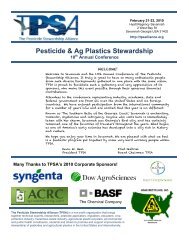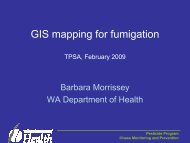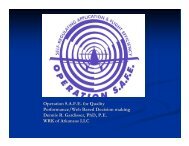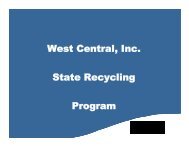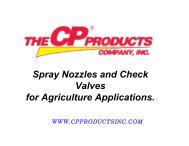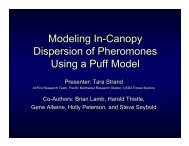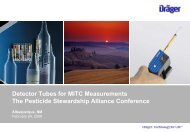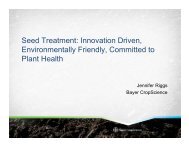EPA's Pesticide Container-Containment Regulations: A Primer
EPA's Pesticide Container-Containment Regulations: A Primer
EPA's Pesticide Container-Containment Regulations: A Primer
You also want an ePaper? Increase the reach of your titles
YUMPU automatically turns print PDFs into web optimized ePapers that Google loves.
EPA’s s <strong>Pesticide</strong><br />
<strong>Container</strong>-<strong>Containment</strong><br />
<strong>Containment</strong><br />
<strong>Regulations</strong>: A <strong>Primer</strong><br />
The <strong>Pesticide</strong> Stewardship Alliance<br />
February 23, 2009
<strong>Pesticide</strong> <strong>Container</strong>-<strong>Containment</strong> <strong>Containment</strong> Track<br />
• EPA’s s Perspective (10:15 – 11:45 am)<br />
• Nancy Fitz, , U.S. EPA<br />
• Retailers’ Perspective (12:45 – 2:15 pm)<br />
• Kevin Runkle, , IFCA & AASA<br />
• Clifford Schoettmer, Schoettmer Enterprises<br />
• Registrants’ Perspective (3:30 – 5:00 pm)<br />
• Marty Fitzpatrick, BASF & CLA Stewardship<br />
• Wendy Bair Johnson, BASF<br />
2
1. Overview: Purpose of the Rule<br />
• <strong>Container</strong>s<br />
• Minimize human exposure during<br />
container handling<br />
• Facilitate container disposal &<br />
recycling<br />
• Encourage use of refillable<br />
containers<br />
• <strong>Containment</strong><br />
• Protect environment from releases<br />
at bulk storage sites<br />
• Protect environment from spills &<br />
leaks at refilling & dispensing<br />
operations<br />
3
1. Rule Overview: Who, What, When<br />
Category<br />
Nonrefillable<br />
<strong>Container</strong>s<br />
Refillable<br />
<strong>Container</strong>s<br />
Repackaging<br />
Products<br />
<strong>Container</strong><br />
Labeling<br />
<strong>Containment</strong><br />
Structures<br />
Who<br />
must<br />
comply<br />
Registrants<br />
Registrants<br />
Registrants<br />
Refillers<br />
Registrants<br />
Users<br />
Ag retailers<br />
Ag comm apps<br />
Ag custom bldr<br />
Major<br />
Require-<br />
ments<br />
Compli-<br />
ance<br />
Date<br />
- DOT container<br />
design, construction<br />
& marking standards<br />
- Dispensing<br />
capability<br />
- Standard closures<br />
- Residue removal<br />
(99.99% removal)<br />
- DOT container<br />
design,<br />
construction &<br />
marking standards<br />
- One-way valves<br />
or tamper-evident<br />
evident<br />
devices<br />
- Vent, gauge &<br />
shutoff valve<br />
standards for large<br />
tanks<br />
- Registrants &<br />
refillers comply<br />
with specified<br />
conditions<br />
- Registrants<br />
develop & provide<br />
certain information<br />
- Refillers obtain &<br />
follow information;<br />
and clean, inspect<br />
& label containers<br />
before refilling<br />
them<br />
- Identify<br />
container as<br />
nonrefillable or<br />
refillable (all)<br />
- Statement to<br />
prohibit reuse and<br />
offer for recycling;<br />
batch code (all<br />
nonrefillables)<br />
- Cleaning<br />
instructions<br />
(some<br />
nonrefillables)<br />
- Cleaning<br />
instructions<br />
before disposal<br />
(all refillables)<br />
- Secondary<br />
containment<br />
structures (dikes)<br />
around large tanks<br />
- <strong>Containment</strong><br />
pads for pesticide<br />
dispensing areas<br />
- Good operating<br />
procedures<br />
- Monthly<br />
inspections of<br />
tanks & structures<br />
Aug 17, 2009 Aug 17, 2011 Aug 17, 2011 Aug 17, 2010 Aug 17, 2009<br />
4
1. Rule Overview: Who & What<br />
• Retailers<br />
• <strong>Containment</strong><br />
• Refillable containers<br />
• Repackaging<br />
• Registrants<br />
• All of the above<br />
• Nonrefillable containers<br />
• Labels<br />
5
<strong>Pesticide</strong> <strong>Containment</strong><br />
Requirements<br />
6
<strong>Pesticide</strong> <strong>Containment</strong><br />
• Do the federal containment regulations apply to my<br />
State or Tribe<br />
• When do facilities have to comply with the federal<br />
containment regulations<br />
• Which facilities must comply with the federal<br />
containment regulations<br />
• What do the federal containment regulations<br />
require<br />
• General Design Requirements<br />
• Specific Design Requirements<br />
• Operational, maintenance, inspection & recordkeeping<br />
7
2. Do the federal containment regs<br />
apply to my State or Tribe<br />
• States that had containment regs by August 2006<br />
have the option of continuing to implement<br />
state regs in lieu of federal containment<br />
regs (if EPA determines the state regs provide<br />
equivalent environmental protection).<br />
• Everywhere else: Federal containment<br />
regulations apply.<br />
8
2. States with <strong>Pesticide</strong> <strong>Containment</strong> Regs<br />
CO MT<br />
FL NE<br />
IL NH<br />
IN ND<br />
IA OH<br />
KS SD<br />
KY VT<br />
LA WA<br />
MI WV<br />
MN WI<br />
MO<br />
9
2. States with <strong>Pesticide</strong> <strong>Containment</strong> Regs<br />
• 21 States submitted requests to continue to implement<br />
their own programs in lieu of the federal<br />
containment requirements, , i.e., for equivalency<br />
determinations.<br />
• July 10, 2007 Implementation Guidance: State cnmt program<br />
is adequate to provide environmental protection equivalent to<br />
the Federal cnmt regs if State regs achieve the same<br />
protection of human health & the environment from<br />
exposure to spills and leaks which may occur during<br />
container refilling or when a stationary container fails.<br />
• OPP makes the determinations of equivalency; working<br />
with Regions, OGC, OECA through this process<br />
• OPP will notify state of determination by letter<br />
10
2. States & Tribes without <strong>Containment</strong> Regs<br />
Key points:<br />
• Compliance required with federal containment regulations<br />
beginning August 17, 2009.<br />
• Region & State/Tribe negotiate expectations for inspections.<br />
Options in draft implementation guidance:<br />
1. Implement federal containment regulations<br />
• Default option; no State/Tribal regulations<br />
2. Issue State/Tribal regulations that incorporate federal<br />
containment regs by reference<br />
3. Issue State/Tribal regulations that are identical to federal<br />
containment regs<br />
4. Issue State/Tribal containment regs that are different than<br />
federal containment regs<br />
• Important for State/Tribal regs not to conflict with federal regs (which apply<br />
regardless of what State/Tribe does)<br />
11
3. Compliance Date<br />
§165.80(c)
3. When do facilities have to comply with the<br />
federal containment regulations<br />
• Compliance is required with the federal<br />
containment regulations by<br />
containment regulations by August 17, 2009.<br />
• Except in States that EPA has authorized to continue to<br />
implement state regs in lieu of federal regs<br />
• Bad news: about half of a year to implement<br />
• Good news: Most bulk facilities have<br />
containment already<br />
• American Agronomic Stewardship Alliance (AASA)<br />
inspections past 4 years show that most facilities<br />
have secondary containment and pads<br />
13
4. Scope of the<br />
<strong>Containment</strong> <strong>Regulations</strong><br />
§165.81 and §165.82
4. <strong>Containment</strong> - Scope<br />
Need to consider three things to<br />
determine whether a facility must<br />
comply with the containment<br />
regulations:<br />
1. Is the facility included<br />
2. Does the facility need<br />
secondary containment<br />
3. Does the facility need a<br />
containment pad<br />
15
4. Scope: Facilities Included<br />
1. Is the facility included<br />
A facility is included in the scope<br />
for containment if:<br />
• It handles agricultural<br />
pesticides; ; and<br />
• It is a retailer that refills,<br />
commercial applicator, and/or<br />
custom blender.<br />
• Farms are not included in the<br />
scope: based on evidence of<br />
contamination<br />
16
4. Scope: Facilities Included<br />
How do the regs describe these types of facilities<br />
• Retailers that refill: : Refilling establishments who repackage<br />
agricultural pesticides and whose principal business is retail sale s<br />
(i.e., more than 50% of total annual revenue comes from retail<br />
operations)<br />
• Commercial applicators: : Businesses which apply an<br />
agricultural pesticide for compensation (other than trading of<br />
personal services between agricultural producers)<br />
• Custom blenders (as defined in §167.3): Any establishment<br />
which provides the service of mixing pesticides to a customer’s<br />
specifications, usually a pesticide(s)-fertilizer(s<br />
fertilizer(s), pesticide-<br />
pesticide, or a pesticide-animal feed mixture, when…<br />
17
4. Scope: Secondary <strong>Containment</strong><br />
2. Does the facility need<br />
secondary containment<br />
If the facility is included in the<br />
scope (see question #1), it must<br />
have a secondary containment<br />
structure if it has at least one<br />
container that:<br />
• Is a stationary pesticide<br />
container (fixed at a facility or<br />
remains at facility for at least 30<br />
days) and<br />
• Has a capacity that is equal to or<br />
greater than 500 gallons for liquid<br />
pesticides or 4,000 pounds for<br />
dry pesticides.<br />
18
4. Scope: <strong>Containment</strong> Pads<br />
3. Does the facility need a<br />
containment pad<br />
If the facility is included in the scope<br />
(see question #1), it must have a<br />
containment pad if any of these occur:<br />
• Refillable containers are emptied or<br />
cleaned;<br />
• <strong>Pesticide</strong>s are dispensed from a<br />
stationary container ≥ 500 gal or 4,000<br />
lbs for any purpose<br />
• <strong>Pesticide</strong>s are transferred from a<br />
transport vehicle to fill a refillable<br />
container<br />
• <strong>Pesticide</strong>s are dispensed from any other<br />
container to fill a refillable container for<br />
sale or distribution.<br />
19
4. Scope: Exemptions<br />
Stationary containers ≥500 gals/4,000 lbs are exempt<br />
from secondary containment requirements if they:<br />
• Are empty.<br />
• Only hold rinsates or washwater (& labeled so).<br />
• Only hold gaseous pesticides.<br />
• Are for non-pesticide use only (& labeled so).<br />
Dispensing areas are exempt from containment pad<br />
requirements if they:<br />
• Only have gaseous pesticides.<br />
• Only have stationary containers already protected by a secondary<br />
containment unit.<br />
• Are used for dispensing from a rail car (in place less than 30<br />
days).<br />
20
4. Is secondary containment required<br />
Assume that all of these facilities handle agricultural pesticides.<br />
es.<br />
• Scenario 1: A 1,000-gallon truck holding an agricultural pesticide<br />
is at a facility for 2 weeks. The facility dispenses pesticide from<br />
the truck for commercial application.<br />
• Scenario 2: Same as scenario 1, except the truck is at the facility<br />
for 2 months.<br />
• Scenario 3: A commercial applicator facility has ten 200-gallon<br />
minibulk containers.<br />
• Scenario 4: A retail facility (that repackages) has two 450-gallon<br />
tanks that are bolted to concrete.<br />
• Scenario 5: A retail facility (that repackages) has several 5,000-<br />
gallon tanks that are clearly stationary storage tanks.<br />
21
4. Is a containment pad required<br />
A retailer repackages agricultural pesticides from a<br />
1,000-gallon stationary tank. Is a containment pad<br />
required when:<br />
• Scenario 7: The retailer transfers from that tank to<br />
refill minibulk containers<br />
• Scenario 8: The minibulks are rinsed before they are<br />
refilled<br />
• Scenario 9: The retailer transfers pesticides from the<br />
1,000-gal tank into a container on a truck (nurse tank),<br />
which will be taken to farms to refill minibulk<br />
containers<br />
• Scenario 10: The retailer goes to a farm and refills a<br />
minibulk container at the farm<br />
22
4. Is containment required<br />
This same retailer (who has a 1,000-gallon stationary tank with an<br />
agricultural pesticide) is also a commercial applicator.<br />
• Scenario 11: The retailer uses 2.5<br />
The retailer uses 2.5-gallon jugs to fill application<br />
equipment for a commercial application. Is a pad required<br />
• Scenario 12: Does he have to rinse the jugs on a pad<br />
This same retailer also has a repackaging agreement with a<br />
registrant to repackage a different agricultural pesticide into 15-<br />
gallon refillable containers for sale and he stores that pesticide in<br />
a 300-gallon<br />
minibulk.<br />
• Scenario 13: Does this repackaging have to happen on a pad<br />
• Scenario 14: Does the 300-gallon<br />
minibulk container have to<br />
be in secondary containment<br />
23
5. What do federal containment regs require<br />
• <strong>Regulations</strong>: 40 CFR Part 165, Subpart E –<br />
Standards for <strong>Pesticide</strong> <strong>Containment</strong> Structures<br />
• Reg text: pages 25-31<br />
• Regs from ‘06 final rule; in Code of Fed. Regs (CFR)<br />
• Also shows final amendments (Oct ’08): corrections,<br />
clarifications, minor fixes<br />
24
5. What do federal containment regs require<br />
• General design requirements for pads & secondary<br />
containment<br />
• Construction materials, liquid-tight, compatible<br />
• Protect appurtenances, pipes/drains, stormwater<br />
• Specific requirements for pads & secondary containment<br />
• Minimum capacity requirements<br />
• Anchor or elevate stationary tanks<br />
• Pad specifications<br />
• Operational, maintenance, inspection & recordkeeping<br />
requirements<br />
25
6. General Design<br />
Requirements for Secondary<br />
<strong>Containment</strong> Units and Pads<br />
§165.85(a) & (b): New structures<br />
§165.87(a) & (b): Existing structures
6. General Design: Structural Integrity<br />
6-1. Structural Integrity. Do the containment<br />
structures in the following three photos meet<br />
the structural integrity requirement (first<br />
sentence) of §165.85(a)(1) and §165.87(a)(1)<br />
27
6. Structural Integrity – Photo 1<br />
28
6. Structural Integrity – Photo 2<br />
The walls and base are constructed of<br />
reinforced concrete and are covered by a<br />
liner.<br />
29
6. Structural Integrity – Photo 3<br />
30
6. General Design: Liquid-Tight<br />
6-2. Liquid-tight<br />
tight. Do the containment<br />
structures in photo 3 and the following three<br />
photos meet the liquid-tight requirement<br />
(second sentence) of §165.85(a)(1) and<br />
§165.87(a)(1)<br />
31
6. Liquid-Tight<br />
– Photo 4<br />
32
6. Liquid-Tight<br />
– Photo 5<br />
33
6. Liquid-Tight<br />
– Photo 6<br />
34
6. General Design: Appurtenance<br />
Protection<br />
6-3. Appurtenance protection. Do the<br />
containment structures in the following two<br />
photos meet the appurtenance protection<br />
requirement in §165.85(b)(1) and §165.87(b)(1)<br />
35
6. Appurtenance Protection – Photo 7<br />
36
6. Appurtenance Protection – Photo 8<br />
37
6. General Design: Stormwater Protection<br />
6-4.<br />
Stormwater protection. Do the<br />
containment structures in the following two<br />
photos meet the stormwater protection<br />
requirement in §165.85(b)(3) and §165.87(b)(3)<br />
38
6. Stormwater Protection – Photo 9<br />
39
6. Stormwater Protection – Photo 10<br />
40
7. Specific Design<br />
Requirements for Secondary<br />
<strong>Containment</strong> Units and Pads<br />
§165.85(c), (d), (e) & (f): New structures<br />
§165.87(c), (d), (e) & (f): Existing structures
7. Basic Area and Volume Calculation<br />
Formulas<br />
o Surface Area of a rectangle (square feet) = length x width<br />
o Volume (cubic feet) = surface area x height<br />
o Volume (gallons) = Volume in cubic feet x 7.48<br />
o Volume (in gallons) per foot in a cylinder = D² D x 5.874,<br />
where D = diameter of tank (feet)<br />
o Volume of a cone (gallons) = 1.047 x (R²xHC) x 7.48, where<br />
R = radius of tank (feet) and HC = height of cone (feet)<br />
o Displacement = volume of storage containers +<br />
appurtenances within a containment from the top of the<br />
containment wall to the floor<br />
o Net containment = total volume of containment –<br />
displacement<br />
o % contained = Net containment / largest container x 100<br />
42
7-11 What is the volume requirement for a secondary<br />
containment facility that is inside or covered<br />
[§165.85(c)(1) and (§165.87(c)(1)](<br />
A. 100% capacity of the largest container<br />
B. 100% capacity of the largest container plus<br />
displacement of other tanks and appurtenances<br />
C. No secondary containment required for pesticides<br />
stored inside a building or warehouse<br />
D. 125% capacity of the largest container<br />
43
7-22 What is the volume requirement for a containment<br />
pad or dispensing area that is inside or covered<br />
[§165.85(c)(3&4) and (§165.87(c)(2&3)](<br />
A. 100% capacity of the largest container<br />
B. 135% capacity of the largest container<br />
C. No containment pad required for operational area<br />
stored inside a building or warehouse<br />
D. 750 gallons or 100% capacity of the largest container if<br />
less than 750 gallons<br />
44
7-3 The pad in this picture is 18 feet wide by 18 feet long<br />
and 3 inches high. What is the volume of the pad<br />
[§165.85(c)(3&4)]<br />
A. 81 gallons<br />
B. 972 cubic feet<br />
C. 606 gallons<br />
7-4 Would this pad<br />
be subject to the<br />
federal pesticide<br />
containment<br />
regulations [§165.80<br />
& §165.82]<br />
45
Answers to Questions 7-37<br />
3 & 7-47<br />
Answer to 7-3: 7<br />
C - 606 gallons<br />
• Volume = length x width x height<br />
• Volume = 18 ft x 18 ft x 0.25 ft = 81 cu. ft.<br />
• Volume (gal) = Volume (cubic feet) x 7.48<br />
• Volume (gal) = 81 cu. ft. x 7.48 = 606 gal<br />
Answer to 7-4: 7<br />
No, this pad is in the field so it is not at<br />
any of the types of facilities that are subject to the<br />
containment regs in §165.80(b).<br />
46
7-55 An existing secondary containment has an<br />
interior measurement of 55 feet long, 45 feet<br />
wide, and 2 feet high. The containment is<br />
constructed of concrete. The facility has 5<br />
storage containers, one at 25,000 gallons, two at<br />
22,500 gallons and two at 15,000 gallons. The<br />
25,000 and the 22,500 gallon containers are flat<br />
bottom tanks. The two 15,000 gallon containers<br />
are cone bottom tanks. The diameter of the<br />
25,000 and 22,500 gallon containers is 13 feet.<br />
The cones of the 15,000 gallon containers do not<br />
extend below the top of the wall of the secondary<br />
containment. [§165.85(c)(1&2)][<br />
A. What is the gross volume of the secondary containment<br />
B. What is the displacement of the secondary containment<br />
C. What is the % contained in the secondary containment<br />
47
Question 7-57<br />
48
Answer to Question 7-57<br />
5 (A)<br />
• A. What is the gross volume of the secondary<br />
containment<br />
• Answer: 37,026 gallons<br />
• Volume = length x width x height<br />
• Volume = 55 ft x 45 ft x 2 ft = 4,950 cu. ft.<br />
• Volume (gal) = Volume (cubic feet) x 7.48<br />
• Volume (gal) = 4,950 cu. ft. x 7.48 = 37,026 gal<br />
49
Answer to Question 7-57<br />
5 (B)<br />
• B. What is the displacement of the secondary containment<br />
• Answer: 3,970 gallons<br />
• Regs specify that the capacity is 100% (or 110%) of the volume of the e largest<br />
container plus the volume displaced by other containers & appurtenances.<br />
• Largest container is not counted in displacement<br />
• Cone-bottom tanks are above wall; also not counted in displacement<br />
• Displacement = volume of the two 22,500-gallon tanks below wall height<br />
• Volume of cylinder = D 2 x 5.874 x height<br />
• Volume of cylinder = 13 ft x 13 ft x 5.874 x 2 ft<br />
• Volume of cylinder = 1,985 gallons (for one tank)<br />
• Volume displaced = 1,985 gallons x 2 tanks = 3,970 gallons<br />
50
Answer to Question 7-57<br />
5 (C)<br />
• C. What is the percent contained in the secondary<br />
containment<br />
• Answer: 132%<br />
• Net containment = total volume – displacement<br />
• Net containment = 37,026 gal – 3,970 gal = 33,056 gal<br />
• % contained = Net containment/largest container x 100<br />
• % contained = 33,056 gal/25,000 gal x 100% = 132%<br />
51
7-66 To prevent flotation of storage containers within a<br />
secondary containment the storage containers must be:<br />
[§165.85(d)]<br />
A. Anchored<br />
B. Always contain product<br />
C. Elevated<br />
D. Elevated or anchored<br />
52
7-77 Stationary dry pesticide containers must be: [§165.85(f)][<br />
A. Protected from wind and precipitation<br />
B. Stored on a pallet or somehow elevated<br />
C. Enclosed by at least a 6-inch 6<br />
curb that extends at<br />
least 2 feet beyond the perimeter of the container<br />
D. All of the above<br />
E. None of the above<br />
53
7-88 What is the minimum surface area required for<br />
containment of transport vehicles on the operational<br />
pads [§165.85(e)][<br />
A. The front and rear wheels of the transport vehicle<br />
B. The entire tank on the vehicle<br />
C. At least the portion of the vehicle where the hose or<br />
device couples to it<br />
D. At least one valve on the tank<br />
54
8. Operational,<br />
Inspection, Maintenance<br />
& Recordkeeping<br />
Requirements<br />
§165.90 and §165.95
8. Operational Requirements<br />
8-1. To manage the small spill on the<br />
pad in the photo, the facility<br />
must [§165.90(a)]:[<br />
A. Manage the pad to prevent<br />
pesticides from escaping<br />
B. Collect & recover the spill in<br />
a way that is protective and<br />
allows maximum practicable<br />
recovery<br />
C. Clean it up by the end of the<br />
day<br />
D. Manage the cleaned up<br />
material according to label<br />
instructions and all<br />
applicable laws & regulations<br />
E. All of the above<br />
56
8. Inspection Requirements<br />
8-22 If pesticides are being<br />
stored or dispensed on a<br />
containment structure, a<br />
facility must inspect<br />
containers, appurtenances<br />
and the containment<br />
structures: [§165.90(b)(1)]<br />
A. Routinely<br />
B. Monthly<br />
C. Quarterly<br />
D. None of the above<br />
57
8. Maintenance Requirements<br />
During an inspection, an employee<br />
finds a crack in a pad. The employee<br />
notes the crack in the inspection<br />
records, tells the manager about the<br />
crack, and brushes the dirt and dust<br />
from the crack to clean it out. Three<br />
days later, the employee seals the crack<br />
with material recommended by the<br />
registrants of the pesticides dispensed<br />
on the pad and records this in the<br />
maintenance records. [§165.90(b)(2)[<br />
and §165.95(a)]<br />
8-33 Does this response to the crack<br />
comply with the containment regs<br />
58
<strong>Pesticide</strong> <strong>Container</strong><br />
Requirements<br />
Part 165 Subpart B: Nonrefillable containers<br />
Part 165 Subpart C: Refillable <strong>Container</strong>s<br />
Part 165 Subpart D: Repackaging<br />
Part 156 Subpart H: <strong>Container</strong> Labeling
9. Which Products Must Comply<br />
• The nonrefillable container, refillable container and<br />
repackaging requirements apply to all pesticide<br />
products except for:<br />
• Manufacturing use products (MUPs(<br />
MUPs);<br />
• Plant-incorporated<br />
protectants (PIPs); and<br />
• Antimicrobial products that are exempt.<br />
• The label requirements apply to all pesticide products<br />
except for:<br />
• Plant-incorporated<br />
protectants.<br />
60
Key Requirements<br />
• Refillable containers (August 2011)<br />
• DOT packing group III standards<br />
• Marking<br />
• Tamper-evident evident device/one-way valve<br />
• Requirements for stationary tanks<br />
• Repackaging (August 2011)<br />
• Registrants: authorize refillers & develop certain information<br />
• Refillers: : Obtain & follow registrant info; inspect, clean &<br />
label refillable containers<br />
• Compare repackaging requirements to Bulk <strong>Pesticide</strong>s<br />
Enforcement Policy<br />
61
10. Refillable <strong>Container</strong>s<br />
62
10. DOT/United Nations Marking<br />
• Example:<br />
• un 1A1/Y 1.4/200/06/USA883466<br />
• Important: look for X, Y or Z<br />
• X = meets PG I stds (most stringent)<br />
• Y = meets PG II stds<br />
• Z = meets PG III stds<br />
• In DOT regs, , marking with UN symbol:<br />
• Can only be used if package fully conforms with<br />
requirements - 49 CFR 178.3(b)<br />
• Certifies that all requirements are met – 49 CFR 178.2(b)<br />
63
10. DOT/United Nations Marking<br />
64
10. Marking<br />
10-1. 1. a) Does §165.45(d)<br />
require this bulk tank<br />
to have a serial<br />
number or other<br />
identifying code<br />
marked on it<br />
b) If so, would this bulk<br />
tank comply with<br />
§165.45(d)<br />
65
10. Tamper-Evident Device/One-Way Valve<br />
10-2. These photos show<br />
several openings on<br />
minibulk containers.<br />
a) Do these comply with<br />
§165.45(e)<br />
b) What is the definition of<br />
tamper-evident evident device<br />
(See §165.3.)<br />
66
10. Tamper-Evident Device/One-Way Valve<br />
10-3. The valve at the<br />
bottom of this<br />
minibulk is not a one-<br />
way valve.<br />
a) Does this minibulk<br />
comply with the<br />
requirement in<br />
§165.45(e)<br />
b) What is the definition<br />
of a one-way valve<br />
(See §165.3.)<br />
67
10. Tamper-Evident Device/One-Way Valve<br />
10-4. The end user has to<br />
break the tamper-evident<br />
evident<br />
device to remove<br />
pesticide from the<br />
minibulk through this<br />
valve. When the minibulk<br />
is returned, would the<br />
refiller have to clean the<br />
minibulk before refilling it<br />
with the same pesticide<br />
product (See §165.70(g)<br />
& (h).) Why or why not<br />
68
10. Stationary Tanks<br />
10-5. These photos show<br />
stationary tanks that<br />
comply with two of the<br />
standards in §165.45(f)(2).<br />
a) What are the criteria for<br />
vents on liquid tanks<br />
b) What are the criteria for<br />
acceptable valves on<br />
liquid tanks<br />
69
11. Repackaging<br />
70
11. Repackaging: Requirements<br />
• Applies to registrants and refillers (registrants, distributors,<br />
retailers)<br />
• Registrants<br />
• Authorize refillers to repackage their product (written<br />
contract)<br />
• Develop and provide certain information<br />
• Refillers<br />
• Obtain and follow registrant info<br />
• Inspect, clean and label containers<br />
• Recordkeeping for registrants and refillers<br />
71
11. Repackaging<br />
• The conditions for a registrant to allow an independent<br />
refiller to repackage its product are set out in §165.67(b)<br />
for registrants and in §165.70(b) for independent<br />
refillers. . These conditions are intended to assure that<br />
the purposes of registration would be satisfied, as in the<br />
1977 Bulk Policy. In addition, other requirements in<br />
the repackaging regulations revise or change criteria in<br />
the Bulk Policy. The Bulk Policy will be rescinded<br />
when the repackaging regulations go into effect in<br />
August 2011.<br />
• The purpose of this section is to understand the<br />
similarities and differences between the repackaging<br />
standards in the regulations and in the Bulk Policy (i.e.,<br />
how repackaging is currently being done.)<br />
72
11. Regs vs. Bulk Policy<br />
11-1. 1. For each of the conditions for allowing repackaging by<br />
an independent refiller (see and §165.70(b)), assess whether<br />
the condition is the same as, similar to or different than the<br />
Bulk Policy.<br />
1) The repackaging results in no change to the pesticide<br />
formulation.<br />
2) The pesticide product is repackaged at a refilling establishment<br />
registered with EPA as required by § 167.20 of this chapter OR<br />
the product is repackaged by a registered refilling establishment<br />
at the site of a user who intends to use or apply the product.<br />
3) The registrant and independent refiller have entered into a<br />
written contract to repackage the pesticide product and to use<br />
the product’s s label.<br />
4) The pesticide product is repackaged only into refillable<br />
containers that meet the refillable container standards.<br />
5) The pesticide product is labeled with the product's label with no n<br />
changes except the addition of an appropriate net contents<br />
statement and the refiller’s EPA establishment number.<br />
73
11. Regs vs. Bulk Policy (cont.)<br />
11-2. The repackaging regulations include a number of other<br />
requirements, which are listed below. (This follows the<br />
same order as §165.70(e)). Again, assess whether these<br />
requirements are the same as, similar to or different than<br />
conditions in the Bulk Policy, requirements in existing<br />
regulations and/or current refilling practices.<br />
6) The refiller’s establishment must be registered with EPA as a<br />
producing establishment as required by § 167.20 of this chapter.<br />
7) The refiller must not change the pesticide formulation unless<br />
the refiller has a registration for the new formulation.<br />
8) The refiller must repackage a pesticide product only into a<br />
refillable container that is identified on the registrant’s<br />
description of acceptable containers for that pesticide product.<br />
9) The refiller may repackage any quantity of a pesticide product<br />
into a refillable container up to the rated capacity of the<br />
container.<br />
10) There are no size limits for the refillable containers.<br />
74
11. Regs vs. Bulk Policy (cont.)<br />
11)The<br />
refiller must have all of the following items at its<br />
establishment before repackaging a pesticide product into any<br />
refillable container for distribution or sale:<br />
• The written contract from the pesticide product’s s registrant.<br />
• The pesticide product's label and labeling.<br />
• The registrant’s s written refilling residue removal procedure for the pesticide<br />
product.<br />
• The registrant’s s written description of acceptable containers for the pesticide<br />
product.<br />
12)Before repackaging, the refiller must identify the pesticide<br />
product previously contained in the refillable container to<br />
determine whether the container must be cleaned. The previous<br />
pesticide product can be identified by referring to the label or<br />
labeling.<br />
13)Before repackaging, the refiller must inspect each refillable<br />
container.<br />
14)Before repackaging, the refiller must clean each refillable<br />
container, if required.<br />
75
11. Regs vs. Bulk Policy (cont.)<br />
15) The refiller must ensure that each refillable container is properly<br />
labeled.<br />
16) The refiller must maintain records of the contract, refilling<br />
residue removal procedure and description of acceptable<br />
containers.<br />
17) The refiller must maintain the records of the EPA registration<br />
number of the product, the container serial number/identifying<br />
code and the date of repackaging for each time a pesticide<br />
product is repackaged.<br />
18) The refiller must maintain records as required by part 169 and<br />
report as required by part 167.<br />
19) The stationary pesticide containers at the refiller’s establishment<br />
must meet the standards for large stationary containers in<br />
§165.45(f).<br />
20) If the independent refiller is a retailer, the refiller must comply<br />
with the containment regulations.<br />
76
Nonrefillable<br />
<strong>Container</strong>s & Labels<br />
Part 165 Subpart B: Nonrefillable containers<br />
Part 156 Subpart H: <strong>Container</strong> Labeling
Key Requirements<br />
• Nonrefillable containers (August 2009)<br />
• Scope: Tox Category I or II or restricted use vs. others<br />
• DOT packing group III packaging<br />
• Standard closures<br />
• Dispensing capability<br />
• Residue removal standard<br />
• Labels (August 2011)<br />
• Nonrefillable container “type” statements<br />
• Refillable container “type” statements<br />
• Cleaning instructions<br />
78
12. Nonrefillable <strong>Container</strong>s<br />
79
Nonrefillable <strong>Container</strong>s: Requirements<br />
• Requirements for products in Tox<br />
Categories 1 & 2 and RUPs<br />
• DOT container design, construction & marking<br />
stds<br />
• Basic integrity, testing & others at packing group III<br />
level<br />
• Standard closures (ag(<br />
pesticides only)<br />
• Dispensing capability (liquid/5 gal or smaller)<br />
• Residue removal standard (dilutable(<br />
dilutable/rigid, 5 gal or<br />
smaller)<br />
• Recordkeeping<br />
• Requirements for products in Tox<br />
Categories 3 & 4 (not RUPs)<br />
• DOT container design, construction & marking<br />
stds<br />
• Basic integrity only<br />
80
12. Standard Closures<br />
12-1. 1. The containers in the<br />
photo are used to sell a<br />
Toxicity Category I<br />
agricultural pesticide. The<br />
drums each have one closure<br />
that is a 2-inch 2<br />
bung with<br />
buttress threading (5 threads<br />
per inch) and one other<br />
opening. The 2.5-gal jug in<br />
the middle has a 63-mm<br />
screw cap (6 threads per<br />
inch) and the 1-gal 1<br />
jug on<br />
the right has a 38-mm screw<br />
cap (6 threads per inch). Do<br />
these containers comply<br />
with the standard closure<br />
requirement in §165.25(d)<br />
Why or why not<br />
81
12. Dispensing Capability<br />
12-2. 2. These photos were found in<br />
the records of two different<br />
registrants to show compliance<br />
with the “glugging” standard in<br />
§165.25(e)(1).<br />
Do both containers meet the<br />
standard of pouring in a<br />
“continuous, coherent stream”<br />
Why or why not<br />
82
12. Dispensing Capability<br />
12-3. These photos were taken<br />
of a container at a<br />
commercial applicator’s s site<br />
and clearly show that<br />
pesticide dripped down the<br />
container. The pesticide<br />
product is a restricted use<br />
product. Do these photos<br />
show that the registrant is<br />
not in compliance with the<br />
container design standard in<br />
§165.25(e)(2) Why or why<br />
not<br />
83
12. Residue Removal Standard<br />
12-4. The photo shows the rinsate<br />
from four rinses of a 2.5-gal plastic<br />
jug that held an emulsifiable<br />
concentrate that is in Toxicity<br />
Category II.<br />
a) To calculate the percent removal,<br />
which jar would have to be<br />
analyzed to determine the active<br />
ingredient concentration<br />
b) What other active ingredient<br />
concentration would you need to<br />
know to calculate percent removal<br />
84
<strong>Pesticide</strong> Labels: New<br />
<strong>Container</strong>-Related<br />
Statements
13. Label Changes: Requirements<br />
• Identify container as nonrefillable or<br />
refillable<br />
• Re-use & recycling/reconditioning<br />
statements + batch code<br />
• All nonrefillable containers<br />
• Cleaning instructions for<br />
nonrefillables: : triple rinsing and<br />
option to include pressure rinsing<br />
• Applies to rigid containers with<br />
dilutable pesticides<br />
• Household products exempt<br />
• Cleaning instructions before final<br />
disposal<br />
• All refillable containers<br />
86
13. New Label Instructions for<br />
Nonrefillable <strong>Container</strong>s: Requirements<br />
• Nonrefillable container. Do not reuse or refill this container.<br />
Once cleaned, some agricultural plastic pesticide containers can<br />
be taken to a container collection site or picked up for recycling.<br />
To find the nearest site, contact your chemical dealer or<br />
manufacturer or contact [a pesticide container recycling<br />
organization] at [phone number] or [web site].<br />
• Triple rinse container (or equivalent) promptly after emptying.<br />
Triple rinse as follows: Empty the remaining contents into<br />
application equipment or a mix tank and drain for 10 seconds<br />
after the flow begins to drip. Fill the container ¼ full with water<br />
and recap. Shake for 10 seconds. Pour rinsate into application<br />
equipment or a mix tank or store rinsate for later use or disposal.<br />
Drain for 10 seconds after the flow begins to drip. Repeat this<br />
procedure two more times.<br />
87
Summary Diagram<br />
88
For More Information<br />
• Allie Fields: 703-305<br />
305-53915391<br />
• Nancy Fitz: : 703-305<br />
305-7385<br />
• Jeanne Kasai: 703-308<br />
308-32403240<br />
• Gibbs Moore: 703-305<br />
305-7102<br />
• David Stangel: : 202-564<br />
564-41624162<br />
• E-mail addresses: lastname.firstname@epa.gov<br />
EPA web site<br />
• www.epa.gov/pesticides<br />
• Select “Regulating pesticides”<br />
• Select “Storage and disposal”<br />
• Select “<strong>Container</strong> and containment regulations”<br />
89



